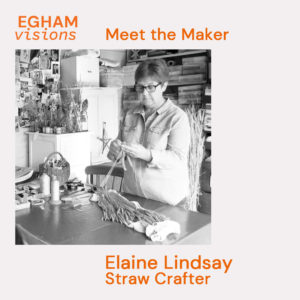
Maker: Elaine Lindsay, Straw craft maker and educator & business owner of https://www.somethingcorny.co.uk/
Interviewed by artist Estella Castle
What first attracted you to the craft?
I was inspired by my sister in law who did all sorts of crafts and at the time I did no crafts and was a riding instructress, so my interest lay outside of crafts and in the country way of life, but I can see the lovely things she was making and I wanted to have a go. At that time I didn’t know what, but being really inspired and I thought I’m going to try. I visited my local craft shop in Inverurie and I already know the shop owner, as her daughter came riding, and very first thing I started crafting was macrame which I really love, but my sister in-law had all ready done it and mastered it so I wanted a craft she didn’t do but I also wanted a traditional craft, and that was something I felt very strongly about. There were some craft catalogues I’d sent for and looking through there was a straw craft kit. I was interested in it as straw was a material that was related to my work with horses. I had not seen corn dollies before but I felt it was very much a country craft, and I’m very much a country person. I was sent a kit, and really struggled. My husband picked up the kit and made a much better job of it so it gave me the push to pick it up and try again. So the craft began with a little bit of rivalry with my sister in-law, but it fitted in with my grandfather who worked locally on farms, and because he had been a horseman on the farms and because of my love of horses we got on very well. He often came with me to the field and would tell me about the old fashioned harvests and we are going back here to the 1920s going into 1930’s, he never specifically spoke about corn dollies, but did talk to me about the harvests. My father owned a croft and my grandfather often helped on the croft, making hay and it just felt that the stories he told me, it felt right, like it was meant to be, even though I started after he died , I found as if I had found my craft and it was a link back to him, but also at the time I was a riding instructress and people around me found interested my work interesting as the material was just something common in the stables, folk were quite fascinated.
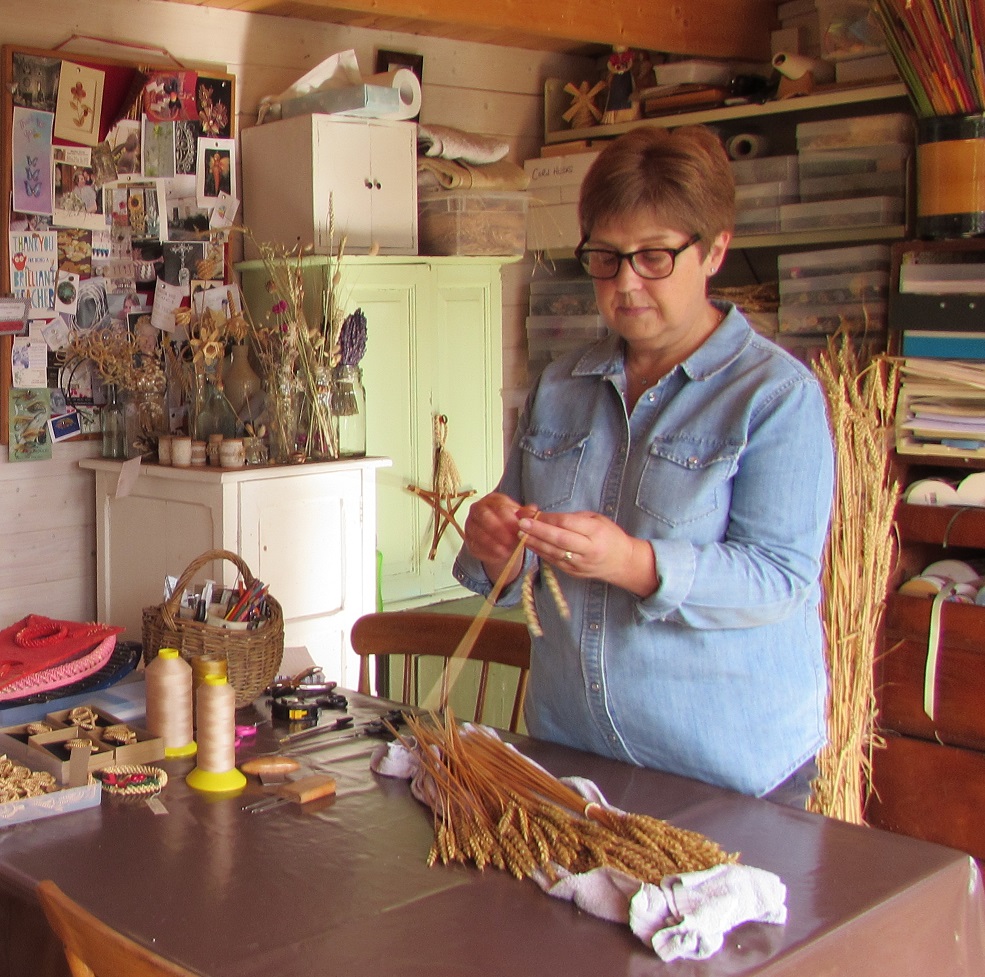
Elaine in her studio
What do you like about the material, you described to me that you enjoy the preparation stage of the straw as ‘getting to know it’, what features of the material do you most like?
I love everything about it. I love to see it growing in the fields and I love working with it. It’s such a simple material, at first glance you would think you can’t do anything with it. I love the colour, love the smell. I get frustrated that some years the straw is not as good as the year before but that’s part of the material, each year the straw will be different. It’s also a natural, I love natural materials and what I can do with materials rather than going to Hobby Craft and buying synthetic or manmade materials. When I see straw, right away my mind is racing to what I can make with it. I have friends who have a farm and they will give me oats to see what can make with it, oat straw is softer and waxier compared to the wheat.
When did this become an occupation rather than a hobby?
I started in 1984, and I already mentioned I used to produce pieces and took things along to the riding school I worked at and within in a year or so I was selling pieces. I was asked along to a craft fair by a friend and pestered by her to participate and bring something (corn dollies) different to the fair. It was a disaster as nothing sold, but I loved watching how others ran their businesses. I took a break from my (instructing) work to raise my family and I thought I could make a little money selling on the weekends at crafts fairs. I started selling at craft fairs for ten years or so in 1990 and it grew organically and I began to get a name for myself, and was invited to give talks and classes. I meant to go back to my work as a riding instructor when my two sons were older, but I realised that the straw craft had really taken off, so went and met with a business adviser in 2000 and that’s when my business Something Corny was formed.
In our first phone conversation you spoke beautifully about some experiences you had in your straw-craft workshops, that the action of making straw crafts triggered memories for some of your older participants, to hazy memories in their youth and childhood, and a time pre the revivelist movement of straw craft when to its original part of a rural calendar. What would be the one remembrance that most struck you?
That is a difficult question to choose just one, however there was one lady who lived in a care home and during my session there I passed around samples of my work, this particular lady chatted away about her memories of the old fashioned harvests and the craft, and afterwards her carers told me that lady was normally withdrawn and quiet and never took part.
Not talking about corn dollies, but rather straw crafts, there have been folks who remembered their grandfathers wearing knots and brooches made with straw during the harvest. I really enjoy when I teach workshops that it sparks folks memories and experiences of the craft a long time ago back in the harvest fields.
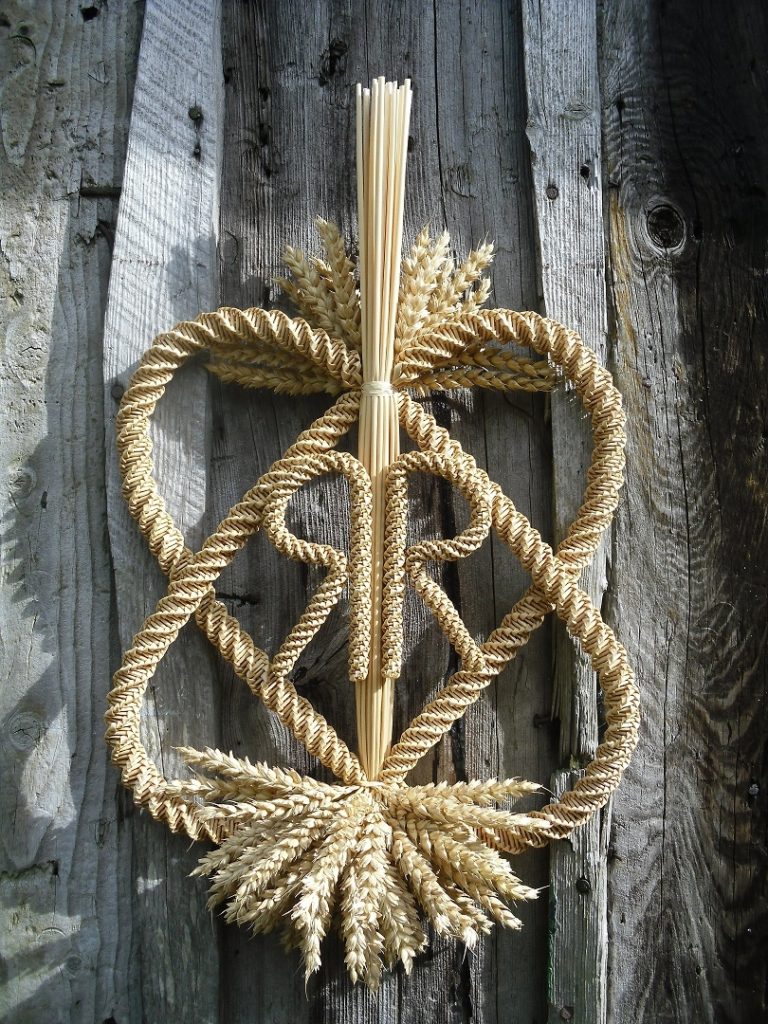
Elaine’s straw craft example of a Commemorative Double Mordiford 
Elaine’s straw craft example of a Straw Maiden 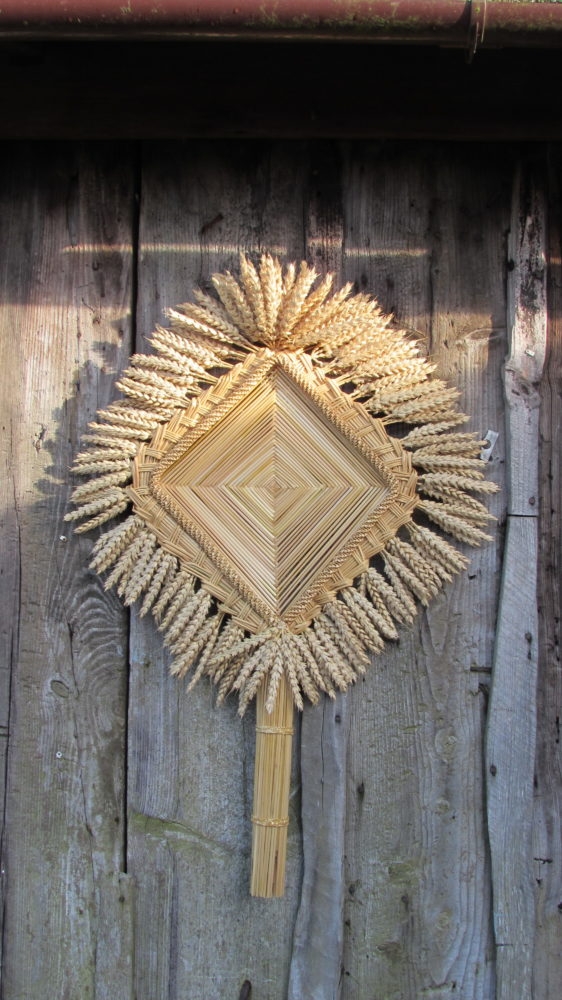
Elaine’s straw craft example of a Welsh Fan
How has the craft changed in design and meaning over the years? Who are the key makers and why do we not know the names of the makers pre the early 1900’s?
Quite quickly when I started selling work, there were two schools of thought, people that wanted corn dollies, and remembered them and only attached one meaning to them and those that were saying this is a house blessing, or fertility symbol, when really they were just a harvest token.
We don’t know the names of the makers as it was not something that was revered, as it was something made out on the harvest field and it was destroyed the following year. Some were roughly made and some finely made, but they were not necessarily seen as an art form, that’s why people don’t remember corn dollies until they see them and the memories come flooding back.
What relevance and benefits do you think the craft has that might attract a new generation of crafters? You mentioned the use of the craft in fashion commissions you have undertaken, what other uses and roles could the craft have today?
Definitely the natural material, I find more and more customers are looking for a natural material when they buy or come to learn the craft. I think people enjoy hearing the stories and feeling like they are keeping a tradition going. The various fashion designers I have worked with have changed the way people look at me as a straw crafter, when I started working with the fashion industry people took me more seriously and it changed how people looked at my craft. A lady came to a fair I was at and asked if I could teach her group of young art students, “I’m trying to teach them about different mediums and materials, and will you teach them what you do”. I gave them the instructions and told them about what a corn dolly was and what they were for, and this group of girls looked like they were falling asleep and I realised that I was losing them quickly! So I quickly produced some photos (of fashion collaborations), and said “but look what I’ve been making recently”, and suddenly it got them and it changed the whole feeling in the class. It was a big learning curve for me. It’s the younger folk we need to teach, yes keep the traditions, but yet move (the craft) forwards and how can we use the material and bring it up to date.
What is something that you haven’t made that would be a dream project, or perhaps a collaboration with another maker or designer?
My head is full of ideas. I see ideas all this time, this virus is giving me more time to be at home and experimenting. When I made this a business I didn’t realise how busy I would be, the things I want to make are all stored away in my head, this quiet time has given me the time to revisit them.
I’m however more focused on recording and teaching the craft, and teaching people what’s possible with it. The more people think of these things themselves, then people start seeing that they can design things for themselves. I love making and working on projects, I really enjoy that but I get much more satisfaction from teaching and passing the skill on than making.
I’d like to do more projects in book form or video, so if something happens to me my work will continue. It’s that kind of work that I feel strongly about and I’d like to do more research about the history of the craft, especially in the north east of Scotland so these stories and memories are handed down for generations to come.
What advice would you give to someone starting out?
Not to be afraid to try new things, often people are frightened to start out. Thinking of my own experience working on my own in Scotland, when I started to spread my wings and got involved in some groups, I was too afraid as so many fellow members said that things that I made were the wrong way to do it, the message was not to experiment or push the boundaries I went to a fascinating talk by a lady who was working with straw but showing that we need to open up our minds to new ideas. She was cut from the same cloth as me, pushing boundaries. Anyone should be able to pick up the straws and experiment with the materiel and not be frightened to try to experiment with it.
I’m all about encouraging people to have a go. There is no right or wrong, if we want the craft to progress new eyes will have to see the craft and the materials in a different way. Just pick up the straw and try it. Often folks will say they can’t do and they make a little favour and they are so pleased with themselves.
My real pleasure comes from people getting it and enjoying it. I taught a blind lady, and she made such a good job and she did better (than the others in the class) because she had to feel the material and get to know it better and she said “my husband will never believe I’ve done this”, people will find ways, get straw in folks hands’ and let them get on with it.
Would you welcome newcomers to the craft turning it into a profession and making money from it?
Yes I think so, initially I thought it would be a rivalry to me, but if anyone is willing to do that hard graft and there are other crafters out there, the competition keeps you on your toes. I think it’s very good if people are seeing this craft more, so the more folk doing the craft the better. I often share designs with folks in America and they share with me as well. Linda Beiler for example wrote a book which is sadly no longer in print. It is great to have people working in the craft to bounce ideas off.
What resources would you recommend?
- There is the Guild of Straw Craftsmen https://www.strawcraftsmen.co.uk/, in this country (Scotland) there is a group called ‘Scottish Straw Workers’, they have a Facebook page www.facebook.com/scottishstrawworkers/
- English based strawcrafter Heather Beeson & I have a Facebook group called ‘Straw Talk’ www.facebook.com/groups/1101922423495189/. In the North East of Scotland we have quite a group of straw workers now. When I started I couldn’t find anyone, pre internet I had no connection with people that were out there making.
- There is my own business https://www.somethingcorny.co.uk/ which sells straw working supplies and finished straw crafts and there’s also Rosemary Sault http://www.simplystraw.co.uk/, where you can buy your materials once social distancing has lifted.
If you would like to learn more about straw crafts and other endangered heritage crafts, visit the Heritage Crafts Association website.
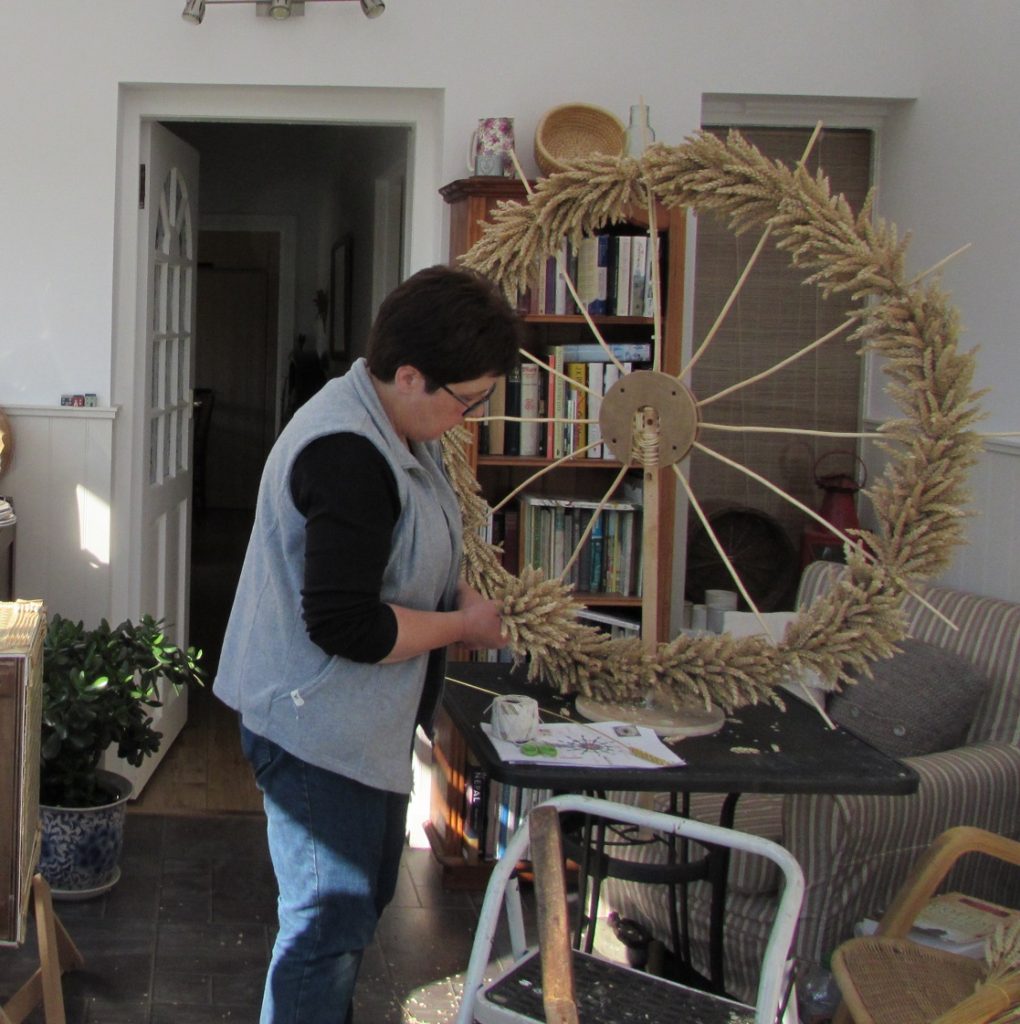
Elaine working on a straw craft piece 
Elaine Lindsay 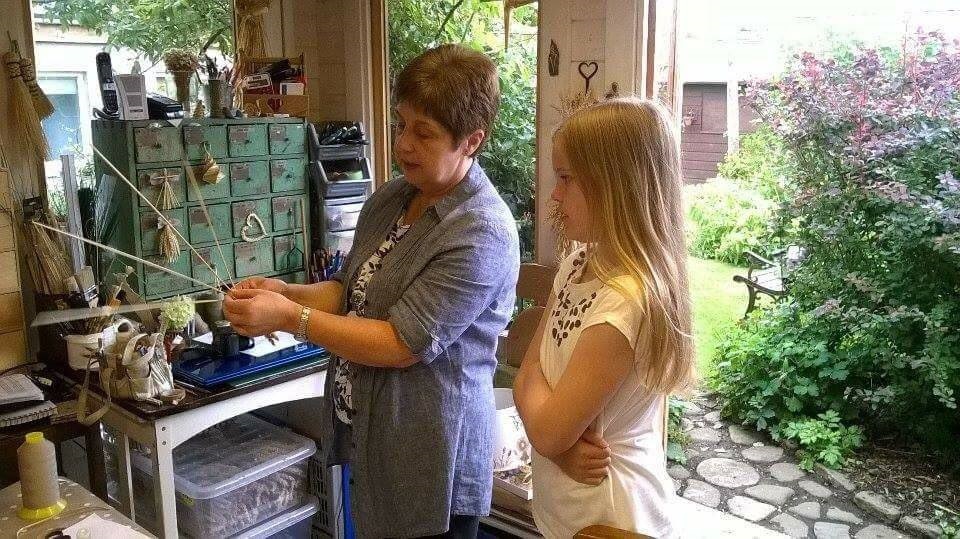
Elaine teaching straw craft
